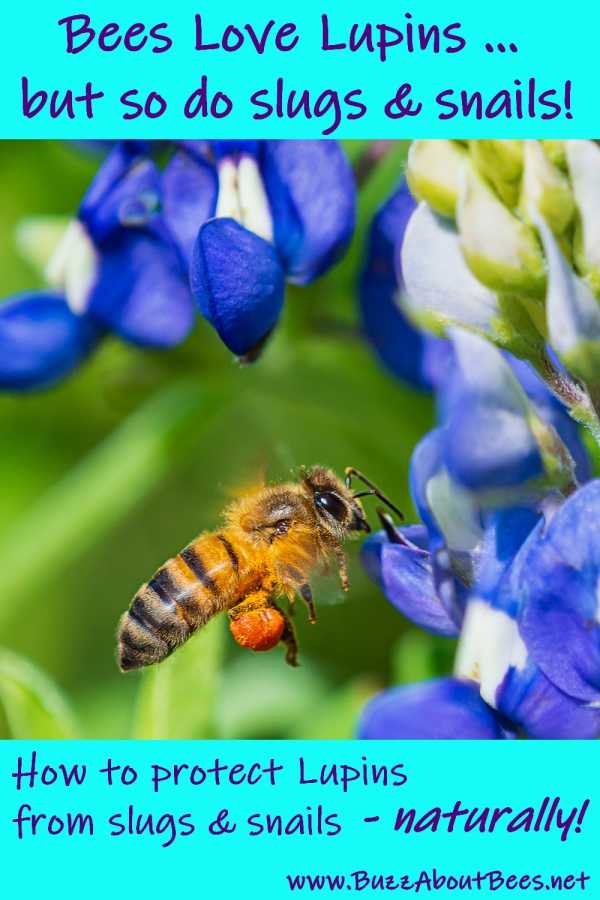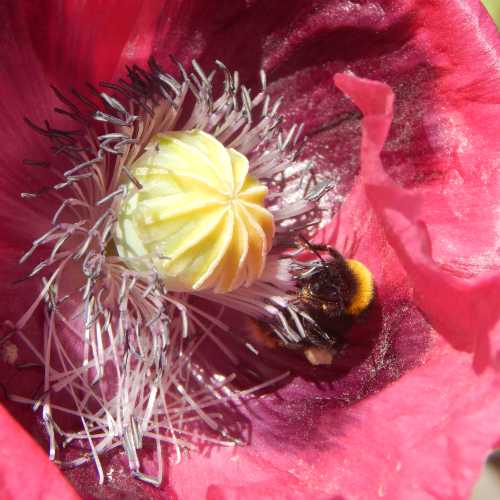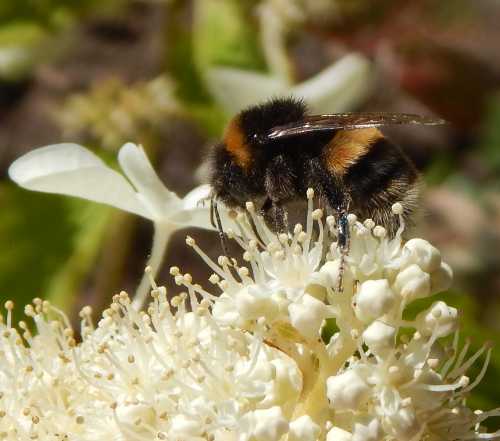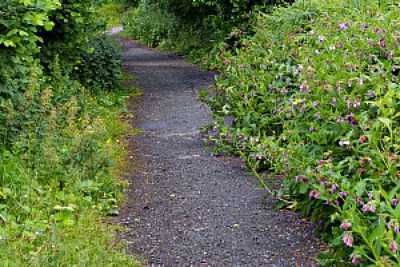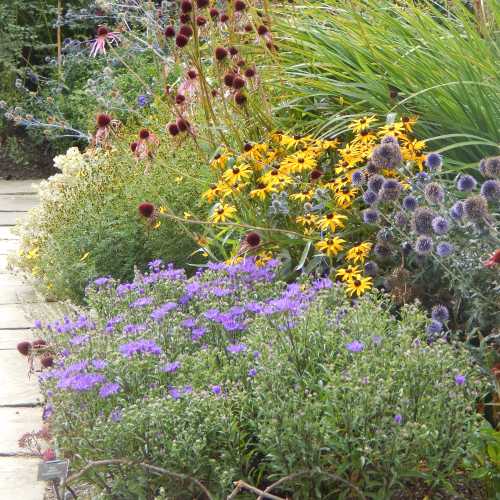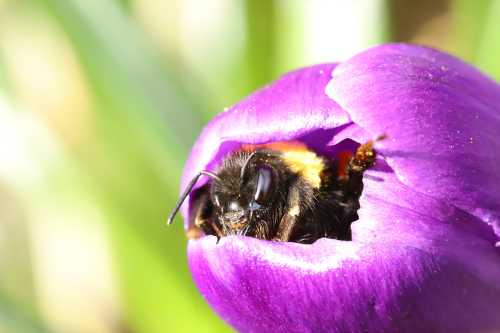Bees Love Lupins (Or Lupine) – but so do slugs and snails, so what can you do?
I always remembered watching bumble bees foraging on our lupins when I was a child, so I was determined to have lupins in our flower border. There are so many wonderful colours available, and I’m a big fan of cottage garden flowers anyway, because so many are loved by bees.
Like clover and vetches, Lupin (or Lupine) are a member of the pea (Fabaceae) family, and have a “flag” shaped blossom. They have carpels and stamens in the lower part of the blossom encased in two petals fused together to form a ‘keel’ – which is used by bees and other pollinators as a landing platform.
Bumble bees especially, seem to have no problem accessing the flowers and are excellent pollinators of lupins, resulting in a pod of seeds after flowering (great for collecting and re-sowing).
The problem is, lupins are loved not only be bees. Slugs and snails rather like them too!
My experience of planting lupins for bees
The first year I tried to grow lupins, I carefully raised a
few from seed, and planted them in the garden. Very quickly – literally within a couple of
days, they were eaten, and sure enough I found the culprits – slugs and snails
among the remains of the leaves.
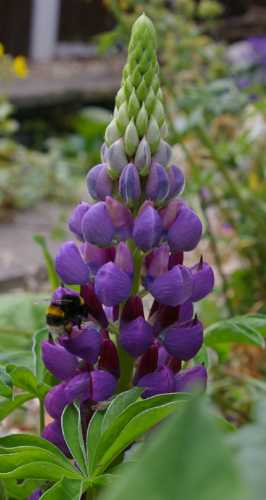 A bumble bee is heavy enough to land on the lupin flower 'keel' and get right inside it, whilst exposing the reproductive parts of the flower, and thus pollinating it and ensuring the flower produces seeds.
A bumble bee is heavy enough to land on the lupin flower 'keel' and get right inside it, whilst exposing the reproductive parts of the flower, and thus pollinating it and ensuring the flower produces seeds.I am a person who will not use slug pellets, because of my concern for other small creatures, including birds, hedgehogs and mice.
More recently I would add dogs to that list of 'creatures' I'm concerned about – or more specifically, our dog, a waggy-tailed spaniel, who likes snuffling around in the garden. I wouldn’t want them to eat the slug pellets.
Anyway, it was a particularly rainy summer, and so I blamed the high level of slug activity on the wet weather.
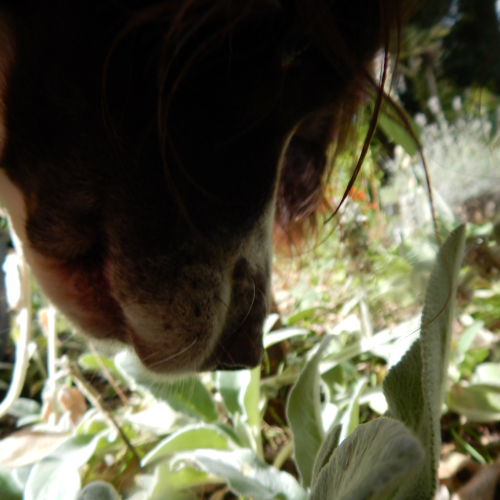 A snuffly-nosed spaniel!
A snuffly-nosed spaniel!The next time I tried lupins, I purchased some young plants from a local community plant fair. This is one of my favourite ways to buy plants, as I can have a conversation with the seller about how the plants have been grown.
Anyway, I bought several nice, small plants, and this time I decided to take special care of them. I kept them in pots until they were quite large and then put them in the garden.
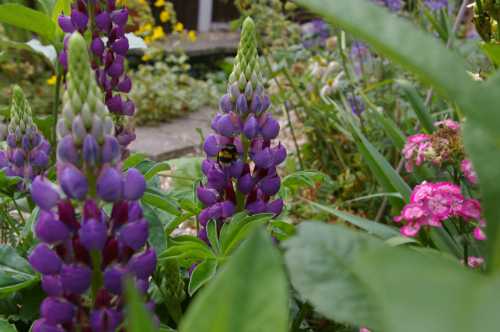 Lupins in my small flower border - at least some were successful!
Lupins in my small flower border - at least some were successful!It helped, and some of the plants developed splendid flower spikes and were foraged upon by bumble bees, however, some of the plants were again attacked by slugs and snails – including the flower heads.
The following year, I decided to take my chances, and see how the plants would fair on their own, with no special care.
Indeed, they grew, and yet again, they were eaten by slugs.
I tried collecting the slugs at night, but yet they caught me out, and I suspect that when I threw them over the hedgerow into the ditch beyond, at least some of them quite possibly made their way back to my lupins!
After this experience, I decided not to bother with lupins, even though bees love them, and instead, focused on plants the slugs were less likely to bother about, such as Linaria purpurea (purple toadflax) and Stachys byzantina (lamb’s ear) which is so loved by wool carder bees.
But the good news is, I have discovered a non-chemical
solution to the slug and snail problem, and I’m going to try it.
How to deter slugs and snails, so you can grow lupins for bees
This slug deterrent has its basis in folklore, yet scientific
study backs it up as a successful deterrent:
garlic.
Garlic can be crushed and made into a drench and foliar spray, so you can protect the leaves and surrounding soil area. I'll reference the scientific study in a moment.
Recipe for garlic soil and plant drench and foliar spray
Try this recipe for a garlic drench:
Crush 2 bulbs of garlic, then add it to 2 pints of water in a pan. Bring the garlic-water to boil in the pan for about 20 minutes. Allow the solution to cool.
Strain the solution to get rid of the crushed garlic. Pour it into a clean bottle and store in a cool place.
When ready to use, add 2 teaspoons of the garlic solution to one
gallon of water, and use it to drench the plants and surrounding soil during the
early stages of their growth. Repeat every week.
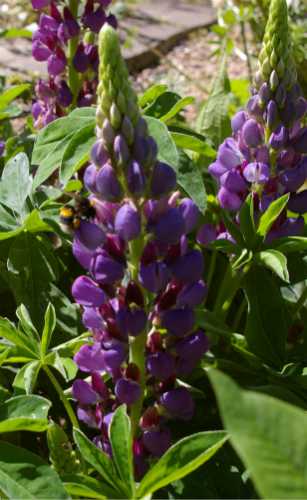 Lupins are lovely cottage garden flowers - bees love them too.
Lupins are lovely cottage garden flowers - bees love them too.You can also make a foliar spray, but personally, I would be careful not to use it on the actual flowers. I have no idea whether or not the odour would repel bees too!
Top up the garlic solution with cold water to 2 pints. Mix one tablespoon with 5 litres of water. Pour the liquid into a spray bottle, and spray the leaves of your lupins in the evening (when the weather is dry). The slugs and snails will not like the garlic, and so will leave them alone. Reapply every 2 weeks.
Is garlic effective against slugs and snails? The science:
Researchers at Newcastle University1 have confirmed that garlic is indeed an effective slug and snail deterrent, and and the paper was published in Crop Protection.
Of the slug and snail deterrents tested, the researchers state that:
"Garlic, ureaformaldehyde and cinnamamide were the three best products for controlling molluscs."
The researchers also point out that in wet conditions, the efficacy of slug pellets can be very low, leading to unsatisfactory control levels, and furthermore, poisonous baits can be toxic to other non-target soil invertebrates, as well as birds and mammals such as shrews and field mice.
Anyone who has pets, especially dogs, would understandably be very concerned about slug pellet use, including in public gardens.
The research was further summarized in Science Daily2:
“Laboratory tests on nine potential molluscicides – the technical term for substances that kill slugs and snails - revealed that a highly refined garlic product (ECOguard produced by ECOspray Ltd.) was one of the most effective killers.
The research was carried out at the request of the crop growing industry and sponsored by the Horticultural Development Council and the Department for Environment, Food and Rural Affairs. It provides scientific proof of garlic's pest controlling properties, and should help businesses developing new treatment products for widespread use.”
Bees love lupins - and they are easy to grow!
You can grow lupins from seed:
- If the seeds are from a packet, soak the seeds over night in lukewarm water, then sow indoors from March to May.
- If you gather them straight from the flower pods, sow directly into the ground (no need to soak) - this will probably be around August/early autumn.
- Lupins like a sunny spot and well drained soil.
- When the spikes are in full bloom, sit back and enjoy watching the bumble bees feeding on these fabulous flowers!
Refs:
1. I Schüder, G Port, J Bennison, Barriers, repellents and antifeedants for slug and snail control, Crop Protection, Volume 22, Issue 8, 2003, Pages 1033-1038, ISSN 0261-2194, https://doi.org/10.1016/S0261-2194(03)00120-0.
2. https://www.sciencedaily.com/releases/2003/09/030912071959.html
FREE PDF DOWNLOAD:
Planning And Planting A Bee Friendly Garden
If you found this page helpful or interesting, I'd really be grateful if you would share it with others - if not this page, perhaps another, such as Gardening For Bees.
Thank you so much :) .
